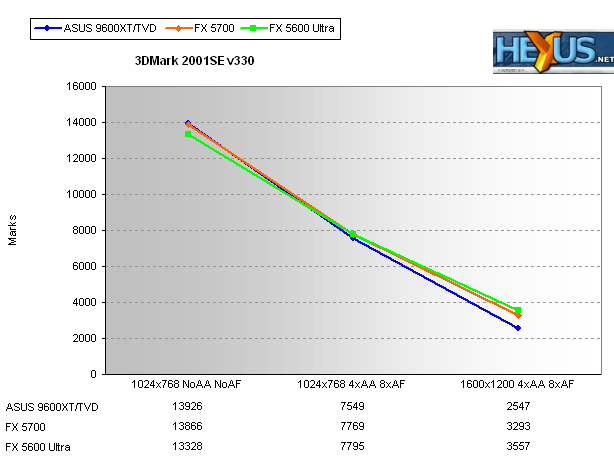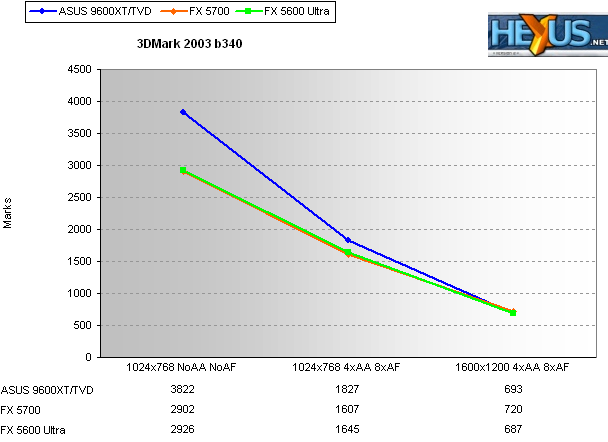3DMark 2001SE and 3DMark03
3DMark2001SE b330- Author: MadOnion/Futuremark
- DirectX Class: 8.1
- Pixel and Vertex Shaders: Yes (Nature test) PS1.1/1.4

I've blatantly plagiarised Ryszard's graphing system here at HEXUS. They say imitation is the sincerest form of flattery. Expect to similar graphs for graphics card-related reviews from now on.
It's a pretty close run affair from the three runners. The ASUS card sneaks top spot in the default test at 1024x768x32, but its performance falls away sharply at the highest quality setting of 1600x1200x32. Is this more to do with the card not being able to use its core and memory functions, along with heavy anti-aliasing and anisotropic filtering adequately, or is it a case of NVIDIA's cards not quite rendering exactly what they should be ?.
It's a difficult one to call. From a purely visual perspective, there's little or no difference. The important fact to remember is that these midrange cards' optimum settings will probably be along the lines of 1024x768x32 with 4x AA and 8x AF applied. In that case, then, the ASUS 9600XT/TVD does well enough.
3DMark03 b340
- Author: MadOnion/Futuremark
- DirectX Class: 9.0
- Pixel and Vertex Shaders: Yes (all tests) PS1.1/1.4/2.0

Futuremark decided to release a new build of 3DMark 03 that attempted to show cards' performance on a level a playing field as possible. It now only allows online, publishable submissions from an approved set of drivers from each graphics card manufacturer. The premise is to rid the benchmark of the controversy surrounding optimised driver sets that artificially increase performance by decreasing overall image quality.
In that respect, therefore, the ASUS card wallops both NVIDIA offerings in the default test. The advantage is kept at 1024x768x32 4xAA / 8x AF and barely surrendered at the highest quality setting. It's now common knowledge that ATI-based cards appear to do better in DX9 benchmarks, and the default test seems to highlight this aspect.
On a tentative note, we'd say that scores in excess of 2,000 marks at the 1024x768x32 level should allow the user to play most modern games at the at resolution and without image enhancement applied. Let's not forget that a vast majority of the public is still running GeForce 1 or GeForce 2 MX-type of cards. These are modern, midrange cards with plenty of clout.









